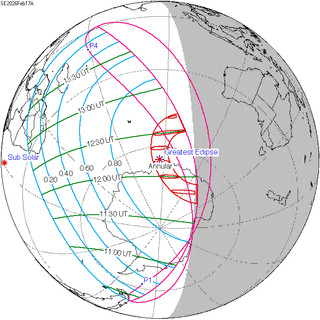| Solar eclipse of February 17, 2026 | |
|---|---|
| Type of eclipse | |
| Nature | Annular |
| Gamma | −0.9743 |
| Magnitude | 0.963 |
| Maximum eclipse | |
| Duration | 140 s (2 min 20 s) |
| Coordinates | 64°42′S 86°48′E / 64.7°S 86.8°E |
| Max. width of band | 616 km (383 mi) |
| Times (UTC) | |
| Greatest eclipse | 12:13:06 |
| References | |
| Saros | 121 (61 of 71) |
| Catalog # (SE5000) | 9565 |
An annular solar eclipse will occur at the Moon’s ascending node of orbit on Tuesday, February 17, 2026,[1] with a magnitude of 0.963. A solar eclipse occurs when the Moon passes between Earth and the Sun, thereby totally or partly obscuring the image of the Sun for a viewer on Earth. An annular solar eclipse occurs when the Moon's apparent diameter is smaller than the Sun's, blocking most of the Sun's light and causing the Sun to look like an annulus (ring). An annular eclipse appears as a partial eclipse over a region of the Earth thousands of kilometres wide. The Moon's apparent diameter will be near the average diameter because it will occur 6.8 days after apogee (on February 10, 2026, at 16:50 UTC) and 7.5 days before perigee (on February 24, 2026, at 23:15 UTC).[2]
Annularity will be visible over Antarctica only. However, the partial eclipse will be visible from the very southern tip of Argentina and Chile, as well in much of Southern Africa (such as in South Africa, Mozambique, and Madagascar).
- ^ "February 17, 2026 Annular Solar Eclipse". timeanddate. Retrieved 13 August 2024.
- ^ "Moon Distances for London, United Kingdom, England". timeanddate. Retrieved 13 August 2024.
